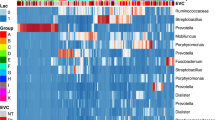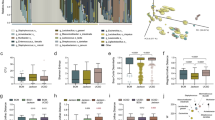Abstract
This study is aimed at a better understanding of the pathogenesis of urinary tract infection (UTI) by examining factors influencing the bacterial ecology of the genital tract. It comprises two sets of experiments in a monkey model. In the first the persistence and transmission between individuals of a P-fimbriatedEscherichia coli (strain DS17) in faeces was examined and in the second we studied the influence of amoxicillin on the occurrence of this strain in the vagina. Orally administeredE. coli DS17 was shown to spread to cage mates and to persist in the gut for at least 17–18 months. One of four monkeys so colonized developed three separate UTIs with the DS17 strain. The second set of expriments comprised four other monkeys, who either harboured theE. coli DS17 strain in the faeces and/or in small amounts in the vagina, probably through contamination during defaecation. Amoxicillin induced a persistent vaginalE. coli DS17 colonization in nine of ten experiments. The study thus shows that uropathogenicE. coli may persist for long time in the faeces and that, in this situation, amoxicillin may promote an abnormal, vaginalE. coli colonization similar to that characteristic of females prone to recurrent UTI and often preceding manifest urinary infections.
Similar content being viewed by others
References
Stamey TA, Timothy M, Millar M, Mihara G (1971) Recurrent urinary infections in adult women. The role of introital enterobacteria. Calif Med 115: 1–19
Bollgren I, Winberg J (1976) The periurethral aerobic flora in girls highly susceptible to urinary tract infections. Acta Paediatr Scand 65: 81–87
Hofmann K, Marget W, Belohradsky B (1981) Veränderte bakterielle Periurethralflora bei jungen Mädchen mit chronisch rekurrierenden Harnwegsinfektionen. Infection 5: 252–254
Brumfitt W, Gargan RA, Hamilton-Miller JMT (1987) Periurethral enterobacterial carriage preceding urinary infection. Lancet II: 824–826
Herthelius M, Hedström K-G, Möllby R, Nord CE, Pettersson L, Winberg J (1988) Pathogenesis of urinary tract infections. Amoxicillin induces genitalEscherichia coli colonization. Infection 16: 263–266
Herthelius M, Gorbach SL, Möllby R, Nord CE, Pettersson L, Winberg J (1989) Elimination of vaginal colonization withEscherichia coli by administration of indigenous flora. Infect Immun (in press)
Winberg J (1986) Balance between host defence and bacterial virulence in urinary tract infection. In: Ashers AV, Brumfitt W (eds) Microbial diseases in nephrology. Wiley, New York, pp 197–223
Svenson SB, Källenius G, Korhonen TR, Möllby R, Roberts JA, Tullus K, Winberg J (1984) Initiation of clinical pyelonephritis — the role of P-fimbriae mediated bacterial adhesion. Contrib Nephrol 39: 252–272
Tullus K, Hörlin K, Svenson SB, Källenius G (1984) Epidemic outbreaks of acute pyelonephritis caused by nosocomial spread of P-fimbriatedEscherichia coli in children. J. Inf. Dis. 150: 728–736
Svenson SB, Källenius G, Möllby R, Hultberg H, Winberg J (1982) Rapid identification of P-fimbriatedEscherichia coli by a receptorspecific particle agglutination test. Infection 10: 209–214
Carlsson B, Gothefors L, Ahlstedt S, Hanson LÅ, Winberg J (1976) Studies ofEscherichia coli O antigen specific antibodies in human milk, maternal serum and cord blood. Acta Paediatr Scand 65: 216–224
Kühn I (1985) Biochemical fingerprinting ofEscherichia coli: a simple method for epidemiological investigation. J Microbiol Methods 3: 159–170
Grüneberg RN (1969) Relationship of infecting urinary organisms to the faecal flora in patients with symptomatic urinary infection. Lancet II: 766–768
Lincoln K, Lidin-Janson G, Winberg J (1970) Resistant urinary infections resulting from changes in resistance pattern of faecal flora induced by sulphonamide and hospital environment. Br Med J 3: 305–309
Jodal U, Winberg J (1987) Management of children with unobstructed urinary tract infection. Pediatr Nephrol 1: 647–656
Bailey RR (1983) Studies to compare various antibacterial regimens in hospital and domiciliary practice. In: Bailey RR (ed) Single dose therapy of urinary tract infection. ADIS Health Science Press, Sydney, pp 7–15
Mackowiak PA (1982) The normal microbial flora. N Engl J Med 307: 83–93
Van der Waij D (1983) The colonization resistance of the digestive tract (chapt 2) and Colonization resistance, antimicrobial therapy and epidemiological consequences (chapt 3). In: Grüneberg RN (ed), Antibiotic choice: the importance of colonization resistance. Research Studies Press, Letchworth, pp 7–55
Hansson S, Jodal U (1987) Treatment of other infections in patients with untreated asymptomatic bacteriuria (ABU). Pediatr Nephrol 1: C88
Author information
Authors and Affiliations
Rights and permissions
About this article
Cite this article
Herthelius, M., Möllby, R., Nord, C.E. et al. Amoxicillin promotes vaginal colonization with adheringEscherichia coli present in faeces. Pediatr Nephrol 3, 443–447 (1989). https://doi.org/10.1007/BF00850224
Received:
Revised:
Accepted:
Issue Date:
DOI: https://doi.org/10.1007/BF00850224




